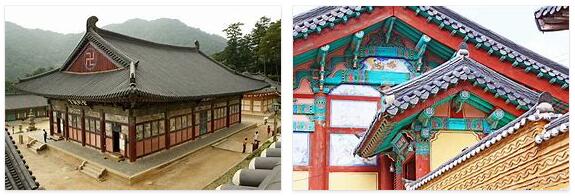The Haeinsa Buddhist monastery complex in the Kaya National Park is of particular importance. The famous more than 80,000 wood printing plates of the “Tripitaka Koreana” are kept here. It is the oldest and most extensive version of the Buddhist textbooks canon of Korean tradition. The monastery is still inhabited.
Temple of Haeinsa: Facts
| Official title: | Temple of Haeinsa (where the tablets of the “Tripitaka Koreana” are kept) |
| Cultural monument: | Buddhist monastery complex in the Kaya National Park with around 250 monks and nuns still today, where the famous printing plates of the “Tripitaka Koreana”, the Buddhist canon of Korean scriptures, are kept |
| Continent: | Asia |
| Country: | South Korea |
| Location: | Haeinsa, west of Daegu, northwest of Busan |
| Appointment: | 1995 |
| Meaning: | Storage location of the oldest and most extensive version of the “Tripitaka Koreana” |
Temple of Haeinsa: History
| 802 | Foundation of a hermitage by the monks Sunung and Ijong |
| from 1009 | under the king Hyonjong printing plate production of the first »Tripitaka Koreana« |
| 1087 | Completion of the »Tripitaka Koreana« |
| 1232 | Destruction of the »Tripitaka Koreana« by the Mongols |
| 1236-51 | under King Kojong, more than 80,000 wooden printing blocks were manufactured again |
| End of the 15th century | Construction of the warehouse complex belonging to the temple, which is still the oldest part of the temple complex and where the second version of the “Tripitaka Koreana” is kept. |
| 1592 and 1597 | Japanese invasions |
| 1817 | Fire of the Haeinsa |
| 1928 | Construction of the “main hall of the great light” |
| 1940 | Construction of the »Shrine of the Three Spirits« |
| 1967 | Construction of the courtroom or hell hall |
Millions of reversed Chinese characters
In the first half of the 11th century, the ruler of the Koryo Empire initiated the production of printing plates for the reproduction of the Buddhist canon. Decades later, this task, which was part of a defensive strategy to repel enemy attacks from the north with the support of the Buddha, was completed. Expectations were not fulfilled: in 1232 the printing blocks went up in flames during an invasion of the Mongols, and the court fled to the island of Ganghwa, west of Seoul. A few years after the Mongol storm, they went back to work there to produce the printing blocks a second time over the course of 16 years.
For almost twelve centuries, the Haeinsa, the “monastery of the seal of the sea”, has been located in the mountain forests of the Kaya Mountain, far from the coasts which in the past were so often in danger. The monastery owes its existence to a miracle cure: the king’s wife suffered from a tumor, and the ruler turned to two monks of a hermitage that existed at the time for help. They pulled a thread around the tumor and tied the other end to a tree. All night long they recited sutras, discourses of the Buddha, at the bedside of the king’s wife. The next morning, what a miracle, the queen was healed and the tree withered…
Today visitors and pilgrims are faced with another miracle: the printing plates of the »Tripitaka Koreana«; 81,340 printing plates made of birch wood, from which Buddhist sutras in Chinese characters – the script used at the time – have been carved out on both sides; 322 characters on each side, i.e. 644 characters per printing plate. Multiplied by 81 340 this is: 52 382 960 characters – reversed of course!
As mentioned at the beginning, this “millennium” was carried out twice! At the beginning the wood had to be prepared, because it shouldn’t crack or warp. The trunks were stored in seawater for three years and then sawn into panels of the same size. These, in turn, were thoroughly boiled in sea water and carefully dried in the shade. After smoothing the surfaces, the characters were brushed onto the boards before the carving knife could be used. Allegedly every carver bowed to the Buddha before he started working on a character…
Did it help? Did some plates even have to be prepared and processed a second time? After all, a Chinese character can consist of up to 62 strokes, so there are plenty of opportunities to make mistakes. Nevertheless: there shouldn’t be a spelling mistake on any record. If someone wanted to read the texts today, assuming they have mastered the Chinese characters, they would need to read the text on a printing plate a day, more than just a human life: the inquisitive would have to live to at least his 226th birthday.
Because Japanese pirates made the coasts unsafe, the plates were brought inland at the end of the 14th century. As legend has it, this could not have happened without the help of nuns, each of whom balanced a plate on their heads. A few more decades passed before the current storage location was completed. The temple has burned down seven times since then, but the magazines have always been intact. During the Korean War, according to militarynous, the Buddha’s teachings, which were fixed in wood, faced this fate again: North Korean troops had holed up in the Haeinsa area. Fortunately, however, an order to bomb the monastery and to accept the renewed destruction of the printing blocks was ignored. This gave rise to the Korean »Tripitaka« (Sanskrit; in Pali » Tipitaka “), The” three basket “of textbooks, instructions on monastic discipline and philosophical discussions.
